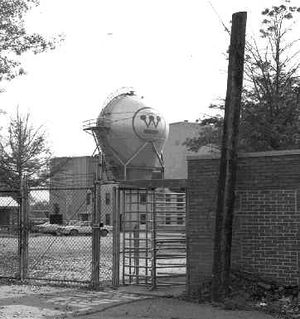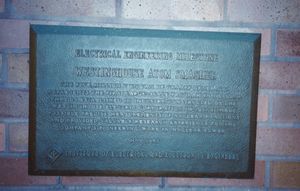Milestones:Westinghouse Atom Smasher, 1937
- Date Dedicated
- 1985-05-01
- Dedication #
- 7
- Location
- Forest Hills, PA, U.S.A.
- IEEE Regions
- 2
- IEEE sections
- Pittsburgh
- Achievement date range
- 1937
Westinghouse "Atom Smasher," 1937
Westinghouse Atom Smasher
The five million volt van de Graaff generator represents the first large-scale program in nuclear physics established in industry. Constructed by the Westinghouse Electric Corporation in 1937, it made possible precise measurements of nuclear reactions and provided valuable research experience for the company's pioneering work in nuclear power.
The plaque was at Avenue A and West Street, Forest Hills, PA. Dedicated May 1985 - IEEE Pittsburgh Section The property has been bought by a developer, and the current (2 August 2019) status of the milestone plaque is unknown. According to this article, some parts of the atom smasher itself are still visible. Article on Westinghouse Atom Smasher
Nearly half a century after its construction in 1937, the Westinghouse Atom Smasher was dedicated as an IEEE Electrical Engineering Milestone in a ceremony held in Pittsburgh, PA, on May 29, 1985. The IEEE History Committee established the Milestone program during the Centennial year as an ongoing means to commemorate events of national and international significance in the history of electrical and electronics engineering.
The Atom Smasher was the centerpiece of the first large-scale program in nuclear physics established in industry. Westinghouse physicists designed the 5-million volt Van de Graaff generator, then the largest of its type in the world, to create nuclear reactions by bombarding target atoms with a beam of high-energy particles. The 5 million volts served as a voltage source to accelerate these particles down a vacuum tube extending from the top of the pear-shaped pressure vessel to a target 47 feet below. The steady voltage of the generator, its chief advantage over other types of accelerators, allowed the reactions to be measured precisely, thus contributing to basic knowledge of nuclear physics. Research with the Atom Smasher in 1940 led to the discovery of the photo-fission of uranium, part of the process involved in the generation of nuclear power.
The remarkable aspect of the Atom Smasher's history is that Westinghouse made the decision to build the generator in 1936, three years before the discovery of nuclear fission opened up the possibilities of nuclear power. Internal records of the early years of the project, which have been collected by Dr. John W. Coltman, former Associate Director of the Westinghouse Research Laboratories, indicate that Company officials embarked on this ambitious program in pure research with the faith that practical applications would follow. The decision proved to be a sound one when, in 1947, Westinghouse formed the Department of Electronics and Nuclear Physics, headed by Dr. William E. Shoupp. One of the original Research Fellows assigned to the Atom Smasher, Shoupp went on to direct Westinghouse's pioneer work in the development of nuclear reactors for submarine propulsion (the Nautilus) and power generation (the first commercial plant at Shippingport, PA). The Atom Smasher continued in operation until 1958, when it was replaced by a more modern Van de Graaff generator, which is still in use.
Dedication Ceremony
Map














